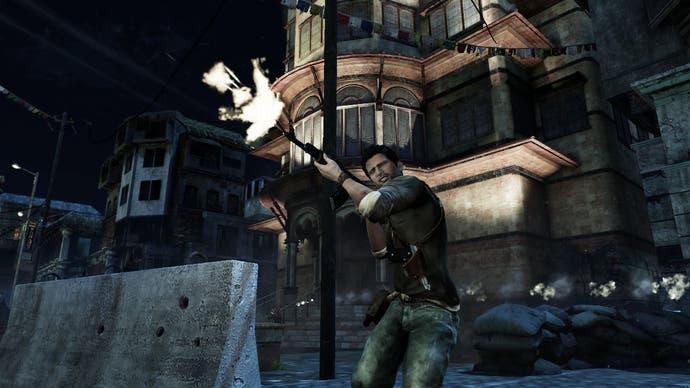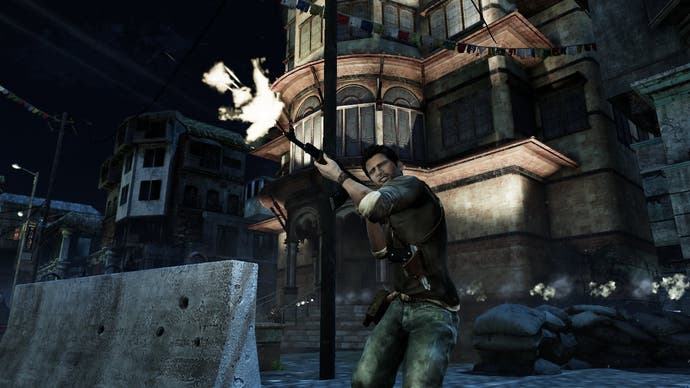Tech Analysis: Uncharted 2
DF humbled by Naughty Dog's coding power.
The free camera mode is also yet another opportunity to put the Naughty Dog tech to the test. It's all about the scene budgets: in a typical game, the developers have a pretty good sense of what the player is "seeing" at any given point, and therefore can hide details in the level that are effectively invisible, lowering the cost of rendering the scene and giving the engine the chance of pump out more frames. But with the free camera mode in Uncharted 2, you can go wherever you want in any given scene, making the job of culling the scene much more difficult.
So, despite those additional challenges, the Naughty Dog tech once again comes out on top, effectively sustaining its 30FPS frame rate with no issues. Indeed, if anything, the game seems to be running smoother than ever.
Cinema mode also includes a photo option, which is again, extremely cool. You can freeze the scene, adjust the camera to wherever you want, push the button and a high quality JPEG is dumped onto the photos area of the PS3 XMB, where you can view it later, copy it off to flash drive, and upload it to the internet.
Various post-processing effects can be added if that's your bag, but you can also get a plain and simple framebuffer dump too, which allows us to finally resolve an age-old debate... Some people have expressed dissatisfaction with the HDMI dumps used in the Eurogamer Face-Off features: there's talk of RGB limited/RGB full, Superwhite on/Superwhite off etc. Well here we have an opportunity to compare a Naughty Dog framebuffer dump with a Digital Foundry TrueHD 24-bit RGB HDMI capture, and put this topic to bed once and for all.


Effectively identical, then, with only the JPEG compression showing any kind of difference. Cinema Mode also offers us the opportunity to perform another technical comparison too. In the early days of PS3 development, software scaling the 720p framebuffer up to 1080p in order to provide support for 1080i/1080p-only displays could incur a significant performance hit; in fact, some people say that it happens with recently released software too, such as the Ninja Gaiden Sigma 2 demo released on the Japanese PSN last week. With Uncharted 2's replay options, we can capture frame accurate gameplay sections and measure them.
Once again, Naughty Dog emerges triumphant. We detected only a 0.05 per cent difference in performance (actually in favour of the 1080p scaled version) – a mere four frames variance over a sample in excess of 8000 frames. Owing to the background tasks going on within the PS3 at any given point, capturing any kind of gameplay video twice will always produce a small, unnoticeable difference, but the bottom line is that despite the additional memory required to scale up that 720p image, and despite the computations necessary to do so, there is no impact to the gameplay whatsoever. Bearing in mind that this is probably the most technically advanced game on PlayStation 3 produced to date, this is no mean achievement.
On the negative side, the scaled picture doesn't look particularly brilliant - even if you own a 1080p display, Uncharted 2 prefers to output native 720p. However, what it does mean is that the game will run in high definition on any HDTV on the market today, even the old 1080i-only CRTs that so many PS3 games have issues with.
So, Digital Foundry's long-standing love-affair with Naughty Dog continues unabated. Thus far, the game's tech has aced every conceivable challenge thrown at it. The question is really whether there's actually anything from a performance perspective that we don't like about this demo? Well, not really. Except for one minor element: what is clearly noticeable is that controller lag has increased in Uncharted 2 over the first game.
Let's be clear about this: we're not talking about the game's netcode, and the latency from receiving data from the other players. With the way client-side prediction works, this is extremely difficult to measure, or even perceive in many cases. We're actually talking about this - the time taken between pressing a button on the joypad and the resulting action occurring on-screen.
Using the same technique used in measuring Killzone 2, I set about measuring controller response in both Uncharted games, and came up with results of 100ms for Uncharted: Drake's Fortune (effectively the fastest a 30FPS game can react), up against 133ms in Uncharted 2. It's worth pointing out that while the exact measurement can't be confirmed until prototype-maker extraordinaire Ben Heckendorn has completed his PS3 controller monitor, the difference in performance between the two games is pretty obvious from the testing. So, what's going on? If anything, shouldn't we be expecting faster response from a more technologically advanced sequel? The short answer is "no". The longer answer is rather more involved.
There are two major factors to be aware of here. First up, there's the plain and simple fact that both the next generation consoles work on the principle of parallelised processing: tasks are distributed between cores, or between the PS3's SPUs, and this can result in additional game latency. Trials HD lead programmer Sebastian Aaltonen has mentioned that even with all the optimisation techniques at his disposal, the multi-threaded version of his game engine runs at a 0.5 frame latency deficit against the original single-threaded rendition on PC.
There's also the fact that over and above all the additional processing going on in Uncharted 2, the game's basic rendering technique – eliminating tearing with minimal drops in frame rate – can also cause extra controller lag. How so?








